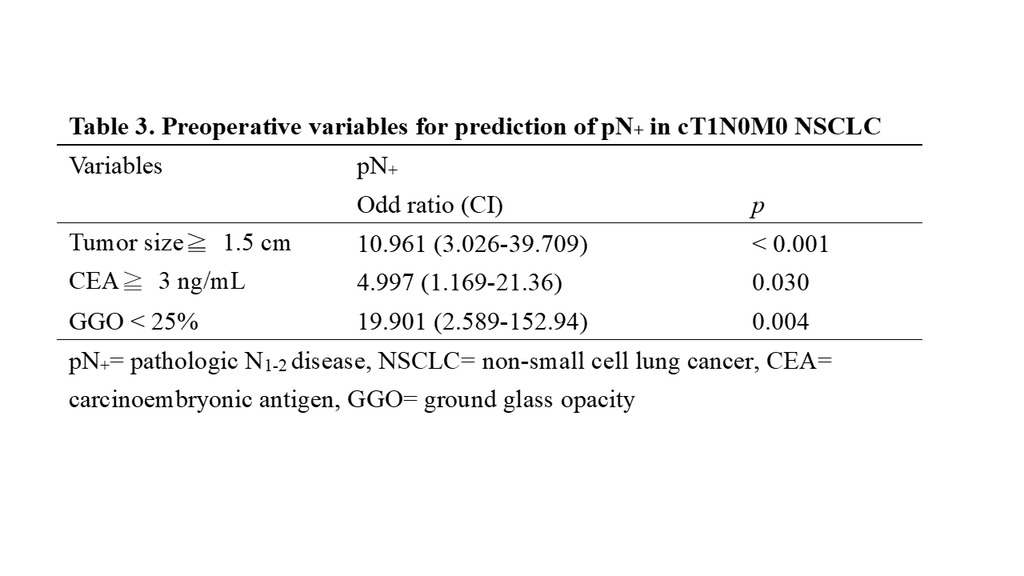Virtual Library
Start Your Search
Tung-Ming Tsai
Author of
-
+
P3.16 - Treatment of Early Stage/Localized Disease (Not CME Accredited Session) (ID 982)
- Event: WCLC 2018
- Type: Poster Viewing in the Exhibit Hall
- Track:
- Presentations: 1
- Moderators:
- Coordinates: 9/26/2018, 12:00 - 13:30, Exhibit Hall
-
+
P3.16-29 - Prediction of Lymph Node Metastases in Clinical T1aN0M0 Non-Small Cell Lung Cancer (ID 13570)
12:00 - 13:30 | Presenting Author(s): Tung-Ming Tsai
- Abstract
Background
Lung cancer with smaller tumor size is now frequently being detected because of prevalent use of computed tomography (CT) as a screening tool for pulmonary lesions. A small group of cT1N0M0 NSCLC have a worse prognosis than what they are expected to be, and nodal upstaging after surgery is a main reason. Prediction of the pathologic nodal upstaging is important. In our study, we aim to reappraise the prediction factors of lymph node metastases in cT1aN0M0 (AJCC 7th edition for lung cancer) NSCLC.
a9ded1e5ce5d75814730bb4caaf49419 Method
Cases of cT1aN0M0 NSCLC after surgical resections in National Taiwan University Hospital from 2011 to 2015 were retrospectively reviewed. The prediction factors of interest are tumor size, tumor ground glass opacity (GGO) percentage in chest CT, and preoperative serum carcinoembryonic antigen (CEA) level. Logistic regression model was done to find predictive factors for nodal upstaging.
4c3880bb027f159e801041b1021e88e8 Result
A total of 770 patients were included for study, 14 (1.8%) were found to have pN+ (nodal upstaging) after pulmonary resection. Larger tumor size, less tumor GGO percentage, and higher preoperative serum CEA level are significant predictors for nodal upstaging. In patholoy, less lepidic component of tumor, presence of visceral pleural invasion, and presence of lymphovascular invasion were also significantly correlated with nodal upstaging. With preoperative variables grouped into categorical data, tumor size ≥ 1.5 cm, CEA ≥ 3 ng/mL, and GGO< 25% have a strong predictive value for lymph node metastases.
8eea62084ca7e541d918e823422bd82e Conclusion
For patients with clinical stage T1aN0M0 NSCLC, tumor size, serum CEA level, and GGO percentage in CT are significant predictive factors for lymph node metastases after surgery. For patients with tumor size less than 1.5 cm, serum CEA level less than 3 ng/mL, and GGO predominant tumor, avoiding lymph node dissection can be justified. Sublobar resection, instead of standard lobectomy, may be a good alternative for this group of patients.
6f8b794f3246b0c1e1780bb4d4d5dc53


